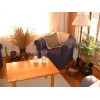|
 Bright, warm colors and the original
African culture are always there to cheer you up, distract one from day to day
routine and bring something fresh and positive into our lives. This is why
ethnic African style is getting popular nowadays and one can see more and more
of it in our houses. Bright, warm colors and the original
African culture are always there to cheer you up, distract one from day to day
routine and bring something fresh and positive into our lives. This is why
ethnic African style is getting popular nowadays and one can see more and more
of it in our houses.
The Main Features of the Style
When speaking about African style in
general one will notice these elements:
-
Cheerful, sunny colors such as: orange,
yellow, sandy brown, terracotta, red. Those are highlighted by bright-blue
color of the southern sky, green oasis' and jungle's colors and black color of
the African nights.
-
The prevalence of natural materials in
furniture and interior: timber (mostly dark toned), bamboo, products of stone
and clay.
-
The unprocessed or hardly processed effects
on the products and furniture.
-
African flora and fauna elements. These
could be plants: palms, rubber plants, ferns, laurels, mini-baobabs or pictures
of those. Fauna representatives can appear in photos, pictures, sculptures
(figurines), or can be seen as skins (or imitations of such), fangs, claws.
Such animals as lions, cheetahs, crocodiles, elephants, giraffes, antelopes,
rhinoceroses, buffalos are very welcome. Your own prairie and savanna can be
observed from the top by marabou and an ostrich who hid somewhere nearby.
Portraying those animals and birds on textile products (bed sheets,
duvet-covers, cloths) will highlight the style and bring this one and only
color, feeling of life joy. Giraffe is translated as colorful and elegant from
Arabian and that is not without a reason.
-
Abstract, a bit of primitive ornaments.
Those are easily noticed due to their juicy colors and easy, simple forms, in
which one will see the world as it is, not spoiled by civilization.
Is this a global change or is it just a few
strokes?
Before making your ideas come true, you
have to decide whether it is a total imitation of Africa for a long time that
you want or it is a few strokes to apply to the interior that can be easily
changed once you feel like it.
Total change
Total imitation of Africa requires a
corresponding walls and ceiling design to make it work. The best solution would
be painting the walls or applying careless plaster in warm, ochre or brownish
colors. Cave-alike African drawings can be used on small surfaces; a
border-ornament can also be used.
Ceramic granite is better to be used on the
floor to imitate natural stone or wood. You can rely on civilization here and
use a floor connected to the heating system for this (you can't expect it to be
cold in Africa, can you?)
Furniture in an African interior should be
of simple, maybe a bit brutal forms without any details that will stand out. If
you prefer more of a light forms, then you should consider getting wattled or
shod furniture Chests are to be used instead of cupboards.
A few Strokes
If you want to only adjust your neutral
interior style with a few strokes of African style the handmade products of the
continent will come to your aid. I'll have to say that craft in Africa was both
an art as well as a way to make life easier. An arty, classy thing would also
serve its owner right.
This can be said about dishware, figurines,
caskets, curtains, covers, shod products, masks, weapons: spears, bows, arrows.
Such artifacts will sure add the needed exotic feeling to the interior.
Plus, wooden or clay dishware should be of
natural clay color and figures, figurines and sculptures should be of
dark-brown or black colors.
A cheetah or zebra skin carelessly lying on
the floor or on the sofa upholstered with a bast fiber would fit a bushman
spear humbly placed next to a wall.
Masks should be used carefully: you'll
never know how their ritual aspect would affect your mood.
Extreme connection with nature, simplicity
and spontaneity; originality of details combined with the mystic world of black
continent fills the interior with this unique energy and originality.
Dina Serebrova
|